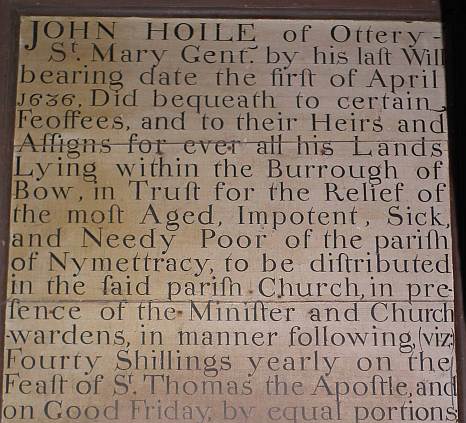John Hoyle (Hoile) Charity

Hoyle’s Gift
John Hoyle of Ottery St Mary had inherited from Edmund Rowland various plots of land in Bow. By his will dated 1 April 1636 Hoyle left these lands to a charitable trust in the names of John Lethbridge, Richard Hole, John Mortimer, Richard Tozer, Markes Lethbridge, William Lethbridge, and Roger Bethem, all of Bow, and their heirs, on the basis that they would thereafter for ever:
a) contribute 1s 3d annually. This was to cover Rowland’s Gift being an annuity of 20s split 3 ways between the poor of Bow, North Tawton and Zeal Monachorum and
b) distribute 40s amongst the most aged, impotent, sick and needy poor people of Bow, half on St Thomas’s-day (21st December) and half on Good Friday.
The charity itself possessed one third part of Hoyle’s 16 tenements in Bow, and received the rent from these. The plan was that the rental profits should be distributed annually, forever, amongst poor parishioners, quarterly or monthly “towards their better relief and comfort, as well as for meat and drink as for apparel and other necessities”. The distribution was to take place in the church in the presence of the parson and church wardens. Each year 2s 4d was taken from the fund to pay the rent collector and 3s 4d for a “potation” (i.e. a drinks party) for the trustees.
In 1813 a problem arose in that some of the tenants objected to a small increase in the rents; the trustees decided to repossess two of the properties. In 1816, the new trustees sued one of these tenants for the overdue rent (6s a year). They lost the court case and incurred costs of over £200.
(In 1813 John Arscott, surgeon of Bow, was renting three fields totalling three acres in Bow called Clapp’s Tenement. The rent was £2 per year.)
After 1818 for a few years no distributions of charity took place while the legal bills were settled.
In the early 1820s the various tenants agreed a small rent increase, although these rents were still below market value because of the outcome of the legal challenge.
In 1872 and 1877 the question of increasing the rent again caused problems. As a result all of the third shares in the land/properties were sold between 1879 and 1884.
On St Thomas’s Day 1910, £21 14s 6d was distributed among 70 recipients.
